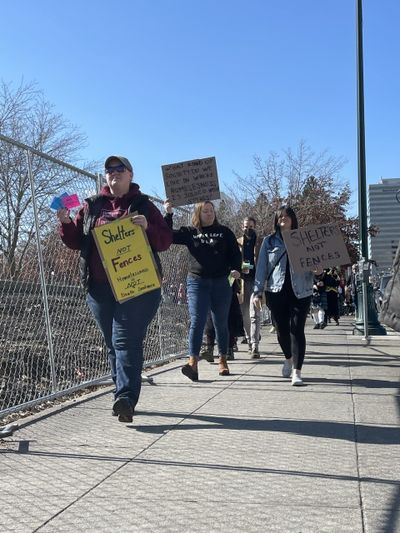‘Shelters, not fences’: Protesters denounce Browne Street viaduct, ask for more homeless shelter beds

With chants of “shelters, not fences,” more than 100 people gathered Saturday to denounce the chain-link fences erected beneath the Browne Street viaduct, advocate for more shelter beds and honor homeless people who have died on Spokane’s streets.
“We are here to remember those who have died in Spokane while homeless,” said Elaina Smith, an Eastern Washington University student who helped organize the protest. “We ask for more low-barrier shelter beds and implementation of emergency shelters during inclement weather.”
After several people addressed the crowd outside the Spokane Intermodal Center, which serves as the Amtrak and Greyhound station in downtown Spokane, the protesters walked to the nearby viaduct on Browne Street and placed on the fences colorful badges each with the name of a homeless person who died since 2020.
About one month ago, the city erected fencing along both sidewalks under the viaduct to deter camping. The fencing narrows the corridor to allow pedestrians through, but not enough for people to set up camp.
Spokane Mayor Nadine Woodward said last month the fencing has resulted in cleaner sidewalks, while adding it’s not a long-term solution to homelessness.
Cassandra Jabbora, who attended the peaceful protest and vigil Saturday, said homeless people are dying on the streets.
“Now we’re going to take the only roof that they have,” Jabbora said. “It doesn’t seem right.”
Michelle Pappas, who held a sign that read, “Homelessness should not be a death sentence,” said she believed the fencing prevents some disabled people from accessing the sidewalk.
She said funding is available to help homeless people, and the fact the city is not doing everything it can to help them avoid intense trauma associated with homelessness is frustrating.
“It’s not just the physical impacts of having housing insecurity,” said Pappas, who used to be homeless. “It’s the emotional impact, the deep trauma that is related to having an experience like that.”
Tim Hilton, owner of Mountain Lakes Brewing Co. in downtown Spokane, told the crowd not all downtown business owners think fencing is a good idea.
“We want Spokane to be a safe place for our customers to come in, but we also want to live in a good community, and taking the only roof that some of these folks have away from them doesn’t make us a strong community,” Hilton said. “So Ms. Mayor, I think we can do better.”
Spokane City Councilman Zack Zappone said the viaduct fencing is only a band-aid.
“We need more shelter capacity and we need it right now,” he said. “Fundamentally, this is an issue about human dignity.”
He said lack of planning has cost taxpayers.
For example, the city likely will pay more than $500,000 for using the Spokane Convention Center as a temporary homeless shelter for two weeks this winter.
Zappone said the region, including Spokane, Spokane Valley and Spokane County, need to work together on the “regional crisis.”
Ben Stuckart, former Spokane City Council president and executive director of the Spokane Low-Income Housing Consortium, said elected officials have failed the people, and that the city and county need to use their millions of dollars in American Rescue Plan Act money for low-income housing and homelessness prevention.
“We can all agree that we want a safe and a clean city, but we also can agree that no one should sleep on the streets,” said Stuckart, who is also chair of Spokane’s Continuum of Care Board, which works to address homelessness. “A roof over your head should be considered a basic human right.”
Julie Garcia, founder of homeless service provider Jewels Helping Hands, asked people to hold up the cards with names of homeless people who have died in Spokane.
“These people died a preventable death on the streets of our city,” Garcia said.
“These are humans and my friends,” she added.
Smith said she and four of her EWU social work classmates were inspired to organize Saturday’s protest after learning about homeless issues in Spokane.
“We already had plans to advocate for needs that weren’t being addressed, and when the fencing was installed, we felt that we shouldn’t waste time anymore,” she said.